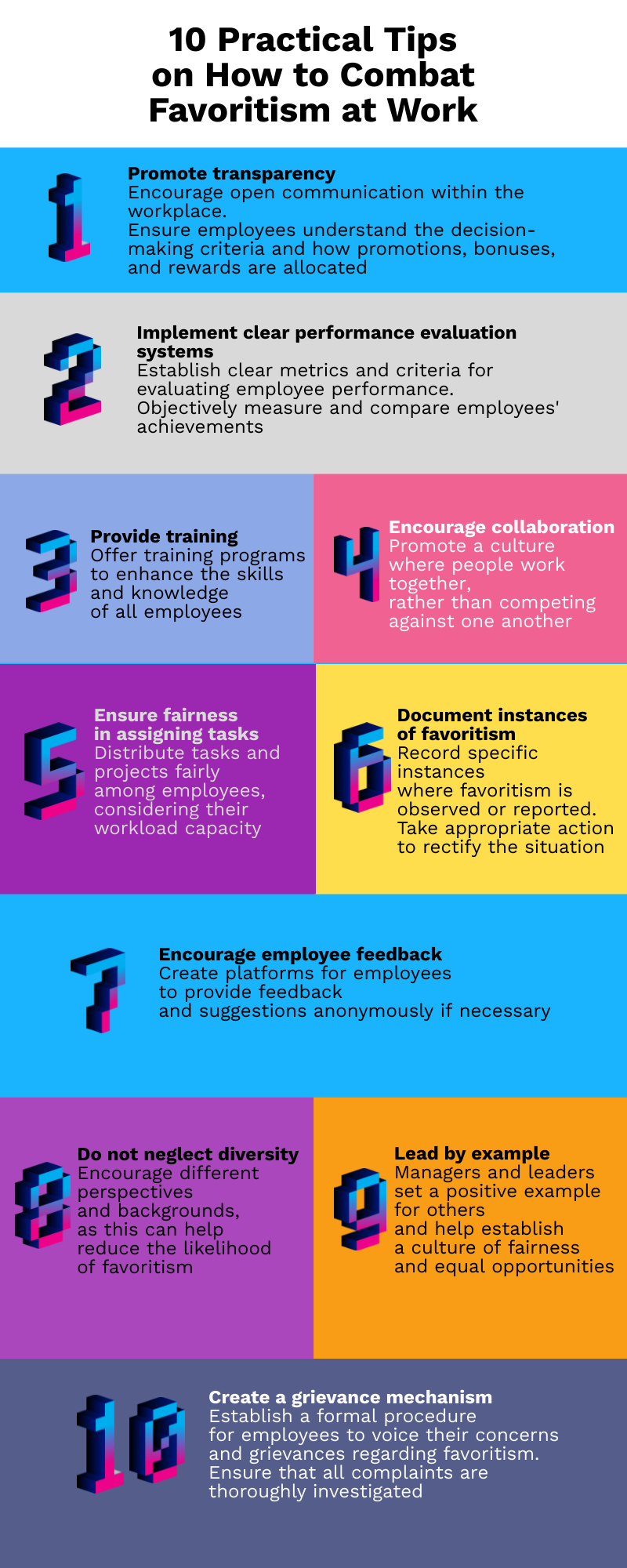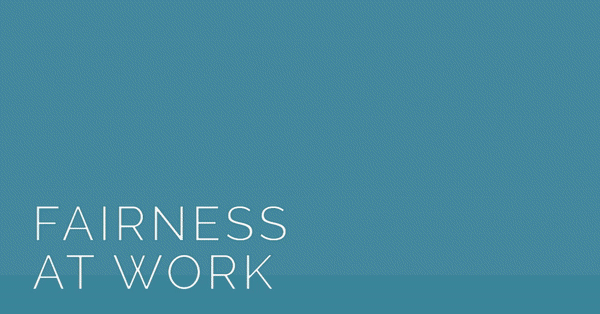How to Identify and Combat Favoritism in the Modern Workplace
Uncover the signs of favoritism at work and learn how TMetric time management features can help create a more equitable and efficient work environment.

Favoritism at work is like a race where the rules are different for everyone.
Favoritism at work is the unfair practice of giving special treatment to some employees or groups, often based on personal relationships, interests, or biases, rather than merit.
Similarly to discrimination at work, favoritism in the workplace stifles innovation and discourages employees from sharing ideas or taking risks.
Preventing Favoritism at Work
Caused by preferential treatment, favoritism leads to workplace toxicity, which can ultimately harm the overall productivity and success of the organization.

The Impact of Workplace Favoritism: Understanding its Effects and Consequences
According to studies, 47% of American employees claimed their supervisor had favorites at work.
Statistics collected by Forbes indicate that 58% of people see signs of favoritism at work.
Proximity bias, a form of favoritism based on physical proximity, is a problem in US offices. Data shows that 96% of US executives admit they're more likely to notice employees who are physically closer to them.
Allowing favoritism to persist in a workplace can have numerous negative consequences.
Some of the most common ones include the following.
Decreased morale: When employees feel they are not treated fairly, morale can suffer. This can lead to decreased motivation, absenteeism, and higher turnover rates.
Reduced productivity: Employees may become less productive when they feel like they are not being rewarded for their hard work. This can lead to a drop in overall productivity and a decrease in the quality of work produced.
Increased conflict: Favoritism can create a toxic work environment where employees are pitted against each other. This can increase conflict and tension between coworkers, decreasing morale and productivity.

Legal issues: If favoritism is based on factors such as race, gender, or age, it can lead to legal issues such as discrimination lawsuits.
Lawsuits for favoritism can arise in various contexts, including employment discrimination, harassment, and retaliation. While favoritism itself is generally not illegal, if it is based on protected characteristics such as race, gender, age, or disability, it may be considered discriminatory and give rise to legal action.
Identifying Favoritism at Work
Favoritism in the workplace can manifest in various ways.
Promotions: A hardworking and deserving employee is passed over for a promotion in favor of someone less qualified but with a closer personal relationship with a manager.
Assignments and Opportunities: Certain employees consistently receive the most desirable assignments, projects, or opportunities for growth and development, while others are consistently overlooked or given less critical tasks.
Informal Interactions: Managers spend more time socializing or having informal interactions with specific employees, giving them an advantage over others when it comes to building relationships and gaining visibility.
Recognition and Rewards: Certain employees receive more recognition, rewards, or praise for their work, even if others have contributed equally or performed better.

Decision-Making: Managers consistently consider the input and opinions of only a select few employees, disregarding or downplaying the contributions of others.
Time Off and Scheduling: Some employees are given preferential treatment when it comes to approving time off requests or scheduling shifts, without valid reasons or in violation of company policies.
Exposure and Opportunities: Certain employees are consistently given more exposure to influential people, essential projects, or high-profile clients, providing them with more significant opportunities for career advancement.
It's important to note that favoritism can be subtle and may not always be apparent. It can create a toxic work environment, decrease productivity, and result in high turnover, damaging business profitability.
Overcoming Favoritism in the Workplace

Establish Clear Policies
Establishing clear and consistent policies is one of the best ways to prevent favoritism.
These policies should include guidelines for the following:
- hiring
- promotions
- disciplinary actions.
Make sure that these policies are communicated and accessible to all employees.
Promote Open Communication
Encourage open communication among employees and management. This can be done through the following:
- regular team meetings
- one-on-one check-ins
- an open-door policy.
Open communication allows employees to voice their concerns or observations about favoritism without fear of retaliation and helps create a culture of transparency and accountability, where employees feel comfortable speaking up if they witness or experience unfair treatment.
Use Clear Criteria for Decision Making
Develop and use objective criteria for making decisions about promotions, raises, and other personnel matters. This can help ensure that decisions are based on merit rather than personal relationships or biases.
Implement Objective Evaluation Systems
Implement a robust performance evaluation system emphasizing objective criteria and KPIs over subjective assessments.
This could be done with:
- setting specific, measurable, achievable, relevant, and time-bound (SMART) objectives
- applying effective performance appraisal systems.
This makes it hard for favoritism to influence promotions or bonuses.
Provide Training for Managers
Conduct regular training sessions on unconscious biases and the impact of favoritism.
Equip employees and managers with tools to recognize and counteract their biases.
Establish a Grievance System
Have a system in place where employees can report favoritism.
This could be:
- an anonymous suggestion box
- a hotline
- a designated person in HR.
This gives employees a safe place to voice their concerns and helps the management identify and address issues of favoritism.
Lead by Example
Ensure that leaders and managers model impartial behavior. Their actions set the tone for the rest of the organization.
Ensure that your leadership team is diverse and representative of the entire organization. This brings different perspectives and experiences to the table when making decisions.
Establish Transparent Feedback Mechanisms
Aside from performance management software, use 360-degree feedback to gather feedback from multiple sources, reducing the reliance on a single person's opinion and minimizing bias.
Conduct Diverse Hiring Panels
Ensure hiring and promotion by applying panels that include diverse members to mitigate unconscious biases.
Review Job Descriptions
Job descriptions can inadvertently contain biased language that may discourage individuals from applying.
For instance, software programs highlighting gendered words can help choose a more neutral language to attract diverse candidates.
Rotate Opportunities
Ensure that high-profile projects, training opportunities, or client interactions rotate among team members to prevent favoring a particular group or individual persistently.
How to Complain about Favoritism at Work
Document specific instances: Keep a record of the instances of favoritism you have observed or experienced. Note down dates, times, and details of what happened. This documentation will support your case when you bring it up with your supervisor or HR.
Review company policies: Familiarize yourself with your company's policies and procedures regarding discrimination, harassment, and favoritism.
Schedule a meeting with your supervisor: Request a meeting with your supervisor to discuss your concerns about favoritism. Be specific about the instances of favoritism and tell how it affects your work experience. Provide specific examples and express your desire for a fair and equitable work environment.
Stay calm and professional: Keeping reserved and within professional boundaries is essential when discussing the issue. Avoid becoming emotional or confrontational, as this may hinder a productive conversation. Focus on the facts, the impact of favoritism on your work, and the overall team dynamics.
Seek support from colleagues: Talk to trusted colleagues who may have witnessed or experienced similar instances of favoritism. Their support and collaboration can strengthen your case and provide additional evidence.
Report to HR or higher management: If your supervisor does not address your concerns or if they are part of the problem, consider escalating the issue to the human resources department or higher management. Follow your company's reporting procedures and provide all the necessary documentation to support your complaint.
Consider external resources: If internal channels do not resolve the issue, you may want to explore external resources, such as filing a complaint with the appropriate government agency responsible for enforcing employment laws. In the United States, this would be the Equal Employment Opportunity Commission (EEOC).
The Role of Time Management in Mitigating Favoritism
Effective time management plays a crucial role in mitigating favoritism in the workplace.
By prioritizing tasks based on urgency and importance, employers can ensure that all employees are treated equally and that deadlines are met consistently.
This creates transparency and helps prevent situations where certain employees receive preferential treatment or extended deadlines.
In particular, managers turn to advanced time tracking solutions when searching for how to deal with favoritism at work.

How TMetric Can Help Prevent Favoritism
Ensuring Fair Workload Distribution with TMetric
TMetric features ensure equal workload by providing a platform for managers to assign tasks and track progress in a fair and transparent manner.
Task assignment: Managers can assign tasks to team members based on their skills, expertise, and availability, ensuring that each employee is given a balanced workload.
Workload visualization: TMetric provides real-time graphs and charts showing the workload distribution across the team, allowing managers to identify imbalances and adjust accordingly.
Time tracking: Employees can log their time spent on tasks, which helps managers monitor workload and identify discrepancies.
Automated notifications: TMetric sends automated notifications when tasks are due or overdue, ensuring that employees stay on track and managers can intervene if necessary.
Performance analytics: TMetric provides performance metrics and reports that help managers evaluate individual and team productivity, enabling them to make informed decisions about workload distribution.
Collaboration tools: TMetric integrations with collaboration tools encourage teamwork and facilitate communication among team members, helping to distribute work evenly.
Customizable workflows: TMetric allows customizing workflows according to specific business needs, ensuring teams can adapt the system to their unique requirements and maintain a fair workload.
Managerial assistance: TMetric provides managers with real-time updates and insights into their team's workload, enabling them to step in and redistribute tasks if needed to maintain a fair workload.
Promoting Transparency and Accountability with TMetric
Using TMetric, managers can ensure that all employees are held to the same standards and that tasks are assigned fairly based on skill set and availability.
This helps eliminate bias and ensures everyone has an equal opportunity to contribute to the team's success.
Conclusion

- Favoritism in the workplace can be insidious and damaging, but some steps can be taken to identify and combat it.
- By keeping track of employee performance, setting an example, and creating a fair and equitable workplace culture, organizations can take a stand against favoritism and ensure that everyone is treated with respect and given an equal chance to succeed.
- Companies can create a more positive, productive, and innovative workplace by working together to eliminate favoritism.
.

